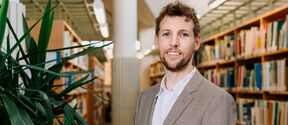Thermophotonics work receives EU funding
Research over the last 10 years has shown that it can be theoretically possible to make light emitting diodes give out more energy as light than they take in as electricity. This seemingly “greater than 100% efficiency” comes from the fact that the ultra-efficient LEDs convert some heat energy into light, causing them to cool down. In addition to cooling applications themselves, another potential future use of this technology would be to use an LED to convert waste heat energy back into electricity by harvesting the emitted light with an extremely efficient photovoltaic device.
Even though most of the fundamental principles enabling these energy recovery devices are routinely observed on a small scale in a laboratory, and known to exist theoretically for a long time, there are a great deal of challenges that need to be overcome before we can make something useful in the real world. Academy Research Fellow Dr Jani Oksanen, who leads the Engineered Nanosystems group at Aalto University coordinates a Horizon 2020 funded project that has been awarded just under €3.5 million to try and solve some of these challenges.
“We can already use an LEDs emission to cool down some parts of the LED itself, but the question is if we can harness the cooling for something useful” said Dr Oksanen. “From there, the question is if we can then capture the photons the LED emits and turn them back into electricity.”
Dr Oksanen and colleagues published a perspective article in Nature Photonics earlier this year detailing the current state of thermophotonics as a research field. Dr Oksanen and his team have identified gallium arsenide as an ideal candidate material for their coolin diodes, as LEDs made from it are able to emit light with a high efficiency and there is a large amount of global expertise in how to make useful devices out of it, including in some of the partner organisations in the Horizon 2020 project. However the vast majority of research into LEDs has focussed primarily on increasing the power density of light emission to make low cost, highly efficient lighting for houses, so many questions about how to utilise LEDs as devices for cooling remain unanswered.
“To reach our goals, we have to try to squeeze out every loss percentage out of the material, in addition to investigating many other trick to optimize the devices for our specific requirements” said Dr Oksanen, “This may be possible both by getting the photons out of the materials better than before, or by transferring them into a different material.”
The Horizon 2020 grant will run for 4 years, starting in January 2021. Aalto University will receive €960,000.
Further information:
Read more news

A new way to measure contagion: the gut bacterium behind blood poisoning can spread like influenza
Neither the antibiotic-resistant nor the highly virulent strains are the most transmissible.Tonmoy Saha Presents Textile Recycling Research at CIMANET Seminar
The CIMANET Research Seminar, held under the theme “Future Leaders in Circular Materials Bioeconomy,” took place on Thursday, December 4, at the Scandic Marina Congress Center in Helsinki.
Textile Chemistry Group Meeting Held
The Annual Meeting of The Textile Chemistry Group held on Thursday, December 11, uniting researchers, doctoral candidates, master’s students, and interns to present their advances in sustainable textile technologies.






